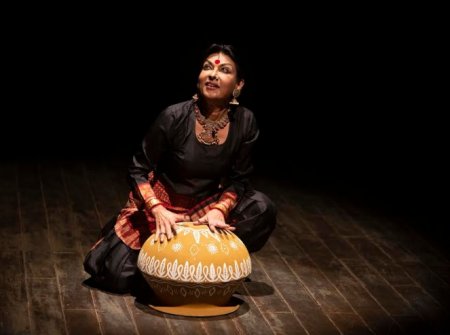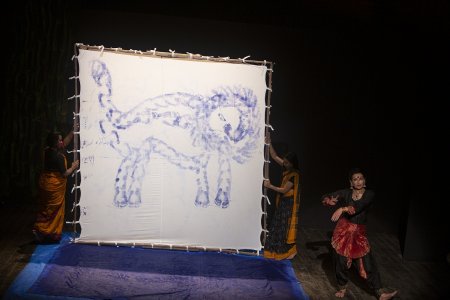
|   |

|   |
Mallika Sarabhai's 'In Search of the Goddess' challenges patriarchal godhood - Dr. S D Desai e-mail: sureshmrudula@gmail.com Photos: Jayanti Sagara March 17, 2020 Art has the power to influence beliefs held even axiomatically. Mallika Sarabhai's In Search of the Goddess, a revival of Devi: the Mother Goddess (1999) challenges the belief in patriarchal godhood. The compact one-hour solo performance as part of Natarani's 'Women's Day Weekend' on March 8 was a brilliant narrative, playfully worded and with beautiful visual translations in dance and drama, that the viewers who had fully packed the auditorium, it seemed found it too short and kept to their seats, expecting more after the obvious end!  To give an indication of the narrative format, Mallika begins with playing the maan in Gujarat's traditional maanabhatt style of storytelling for a couple of minutes. Then she moves onto the earthen pot, again for a couple of minutes, for a very short Kuchipudi performance. Then onwards the whole empty stage, with only a small image of green sprouting bamboo stems as the backdrop on its right, is hers with Bharatanatyam, Kuchipudi and dramatic skills as her resources. Her aharya remains unchanged till the end. Music and sounds keep varying. Lights spell the mood. She denounces the patriarchal bias in our traditional stories of the genesis of the universe. This bias, she says in an aside, has crept into practically all spheres of our lives. Asides and playful action from time with alacrity, incidentally, are a good source of humour for her and they good-humouredly keep the audience with the flow of her narrative convinced. Earth, Lakshmi, Sarasvati, Ganga and Durga were mercifully deified, but strategically many powerful women were ignored, she gets the audience to note. "It was not convenient," she sarcastically observes, to make Draupadi a goddess. She portrays her in first person. "A garland myself, I was garlanded at the swayamvara ... In a crucial decision, I was not consulted... Nuptial knots tied to a shooter of fish!... Became a commodity shared by five men... I the Kaurav Sabha power was truth to Bhishma... As on the Kurukshetra battlefield, wasn't Arjuna in need of counsel in the Sabha?... At the Himalayas, the illustrious husbands, all too eager to be at the portals of swarg, left me behind." The woman who asked inconvenient questions was naturally not made into a goddess. With economy of details, the dancer offers near-caricatures of the men in Draupadi's life. A poem written by Kartikeya Sarabhai many years ago, incidentally, formed part of this episode. With a two-faced mask held aloft on a stick, Mallika with considerable dramatic skill has Savitri narrate her story. She had followed her husband Satyavan in the forest. The performer retreats to where bamboo stems are and has Satyavan's head in her lap when Yama comes to claim his soul. The conversation the chaste and virtuous Savitri has with Yama gets dramatically enacted. Yama finally returns without Satyavan's soul. "I'm a Sati," Savitri asserts, "because I didn't let my husband die." Widows are forced even today to sit on their husbands' pyre and die. To them her message is, "Don't die. I'm a Sati because I did not let Yama win." The one-eyed monkey was a witness to the male conspiracy against a Brahmin woman. The woman doing penance under the tree was so beautiful, Indra descended from above and raped her. On her husband's complaint, with the monkey's testimony, Lord Vishnu found Indra guilty of 'humiliating' a highborn Brahmin's wife and asked him to make amends. Indra obeyed and sacrificed a horse. Everyone, including the couple, was satisfied. The monkey chuckled at the justice given and accepted. Mallika is quick to remind the audience of rapes taking place in India every few minutes every day.  What follows is the most delightful segment of the production - a portrayal of Goddess Katyayani, the sixth of the nine incarnations of Goddess Durga or Shakti, most intolerant of the evil ways of demon Mahishasura and his destroyer. With her dance, Mallika gives glimpses of the beauteous aspects of the primordial goddess Katyayani. In her walk are lessons of graceful movement to the mortals and when she dances charis, coordinated movements of the lower limbs, and karanas, composite movements of hands and feet culminating in a frozen specific pose for a moment, are born. The performer was at her best in conjuring up pleasingly expressive angabhangis in gatibheda. One of the Devi legends says the first stringed instrument came from Mahisha's intestines. Goddess Katyayani mounts her vehicle Simha (lion); with a hymn to her Mallika skillfully draws a lion in blue dancing on a framed white piece of canvas held tight by two girls at two ends as an offering.  Dr. S.D. Desai, a professor of English, has been a Performing Arts Critic for many years. Among the dance journals he has contributed to are Narthaki, Sruti, Nartanam and Attendance. His books have been published by Gujarat Sahitya Academy, Oxford University Press and Rupa. After 30 years with a national English daily, he is now a freelance art writer. |